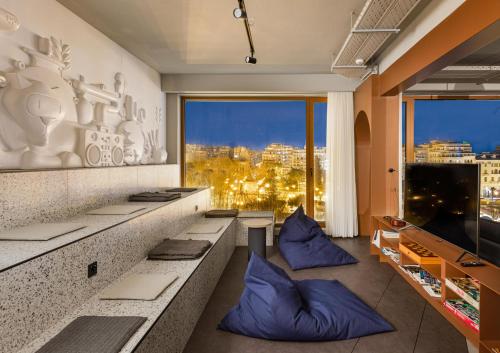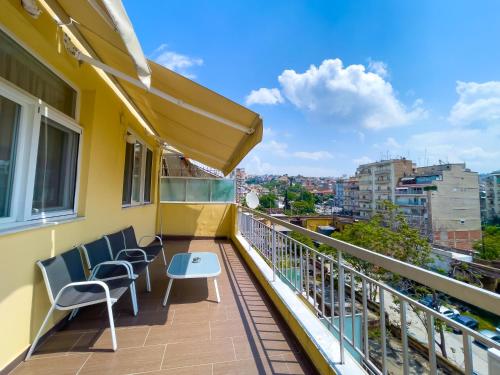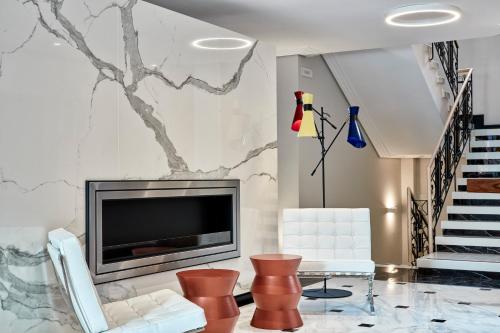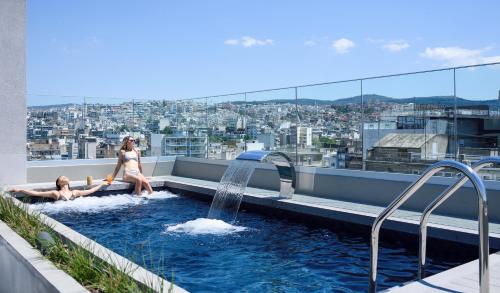It was in about 50 AD, just a handful of decades after Jesus is said to have lived, that Paul the Apostle arrived in Thessaloniki.
Back then, the Greek city was part of the Roman Empire and an important trading centre on the roads between modern-day Turkey, Italy, and the Balkans. Its location and significance were among the reasons why Paul chose to come here.
Paul the Apostle (or Saint Paul, as he came to be known) was on his second missionary journey to spread the word of Jesus and try to convert people to the new religion of Christianity.
For three weeks, he went to the main synagogue of Thessaloniki on the Sabbath and preached. Some people believed him and became followers. Some chased him out of town, as others had done in cities across the region.
But in Thessaloniki, just like many other places Saint Paul visited on his missionary journeys, the seeds had been planted. The Greek city would become one of the first centres of Early Christianity, laying the groundwork for the famous churches of Thessaloniki.
When you visit Thessaloniki these days, almost 2000 years after Saint Paul did, you’ll find an incredible collection of Christian churches.
None is from the time of Paul, but some of them are from some of the earliest centuries of the Christian era. Others are from the Byzantine period, while others came a bit later.
Collectively, the Thessaloniki churches are one of the most important things to see in the city, tracing the development of Christianity and the history of the culture here. They have even been inscribed as one of the World Heritage Sites of Greece.
Why are the churches of Thessaloniki important?
The churches of Thessaloniki have been named as a World Heritage Site because they cover a long period of Christianity from the 4th to 15th centuries, including masterpieces of Christian art and architectural styles that influenced religious design across the region.
What is the most famous church in Thessaloniki?
The most famous church in Thessaloniki is the Agia Sophia (Church of St Sophia), which was built in the 8th century and is a masterpiece of Byzantine design. The other most significant is the Church of St Demetrios, named for the city’s patron saint who was killed on this spot in 303 AD.
Where did St Paul preach in Thessaloniki?
On his first journey to Thessaloniki, St Paul is said to have preached in the city’s main synagogue. It’s not known exactly where he preached when he returned in 56 AD, but the Vlatades Monastery is on the spot where he is said to have drunk water from a natural spring.
Even beyond the historical significance, the churches in Thessaloniki are worth visiting for their art and architecture.
Detailed mosaics, paintings on the walls, and sculptures decorating the nooks. The details of the churches make each of them a unique treasure, regardless of their size.
The largest of the churches appear monumental and are among some of the most impressive Christian landmarks in Greece. While the smaller ones seem to draw you close and into the inner sanctums of the faith.
When it comes to visiting the churches of Thessaloniki, I recommend seeing as many of them as possible, because they each offer something a bit different.
Why are the Thessaloniki churches a World Heritage Site?
There are several reasons why the churches of Thessaloniki were added to the World Heritage List in 1988 – and I think it’s worth understanding them so you can have a deeper appreciation of your visit to the city.
The first reason is that the churches cover three main periods: Early Christian, Byzantine, and post-Byzantine. Constructed over more than a millennium, from the 4th to the 15th centuries, they show the evolution of the Christian faith in this part of the world, from almost the beginning.
The inclusion of the Early Christian churches is also an important reason for the heritage listing because the art that is found within them – particularly the mosaics – are among some of the greatest masterpieces of that era.
When it comes to the later churches, they are also aesthetically significant. The design of the churches in Thessaloniki had a big impact on architectural styles in the Byzantine world, and you can trace how those styles changed through the eras.
They, for instance, had an influence on the appearance of the churches you’ll see when you visit Mystras, a Byzantine centre that is another of the Greek World Heritage Sites.
As I visit World Heritage Sites, I find some of the most interesting ones to be those that represent changes in both the physical and the cultural. These churches are a good example.
You can look at the buildings and their artworks to see how styles changed over a thousand years. Or you can also see them as symbols of how Christianity grew.
From an apostle preaching in a synagogue, there are now churches throughout Thessaloniki. From majestic buildings in the centre of the city to monasteries in the hills, and small chapels in the suburbs, religion influences daily life everywhere here.
Visiting the Thessaloniki churches
Although the churches are spread out across central Thessaloniki, it’s possible to walk between each of them. You can easily see them all in less than a day.
I’ve put together a map here, to show you where all the churches are located:
If you don’t have time to see them all, I would recommend visiting a few of the most important ones in the city centre, then heading up into the hills to see at least one of the monasteries. Then, pop into a couple of the smaller ones along the way.
Those three types of churches will give you a range of styles and eras, which is important because it’s the evolution of the churches that makes them so significant.
It doesn’t go to all the churches, but this Thessaloniki walking tour is a great way to see some of the best ones with a guide.
Now, it’s time to have a look at each of the 15 locations that are included in the World Heritage Site – which may also help you decide which of the Thessaloniki churches you would like to visit.
Thessaloniki’s World Heritage locations
- Rotunda
- Hagia Sophia
- Church of St Panteleimon
- Church of the Saviour
- Church of Acheiropoietos
- Church of Panagia Chalkeon
- Church of St Demetrius
- Church of Prophet Elijah
- Latomos Monastery
- Vlatades Monastery
- Church of St Nicholas Orphanos
- Church of St Catherine
- Church of the Holy Apostles
- Byzantine Bath
- City Walls
Rotunda
Let’s start with the Rotunda, which is one of the oldest monuments in Thessaloniki. It was once part of a much larger group of monuments called the Palace of Galerius, built by the Roman Emperor Galerius (whose palace in Serbia, Felix Romuliana, is also a World Heritage Site).
The Rotunda was built in the early 4th century and is an enormous circular building with walls that are up to six metres thick, and a high domed roof.
The central area feels cavernous these days, but it would once have been filled with people when it was used as a church. (It was originally intended to be a mausoleum for Galerius, and later became a mosque.)
The walls and ceiling were once covered in vibrant mosaics and, although most are now gone, there are fragments still in place that give you an idea of how they might’ve looked.
The Rotunda is the only one of the World Heritage locations to have an entrance fee. It costs €6 for a standard ticket and €3 for a concession.
The Rotunda is open Wednesday to Monday from 8:00 – 20:00. It is closed on Tuesday.
Hagia Sophia
Even if you are short of time, the Hagia Sophia (also known as the Church of St. Sophia) is one of the main attractions of Thessaloniki, and well worth visiting.
The current structure of the Hagia Sophia was built in the 7th century, although there was a church here from as early as the 3rd century. It’s one of the oldest and most important in the city.
Inside, there are several different areas that you’ll be able to explore, each filled with stunning mosaics and wall paintings. The iconostasis (the screens that separate the sanctuary from the nave) is particularly noteworthy, decorated with gilded shapes and painted portraits.
Church of St Panteleimon
Between the Rotunda and Hagia Sophia, is the Church of St Panteleimon, built in the late 13th century. If you’re short of time, this is a good one to visit to see an example of a later Byzantine church.
The Church of St Panteleimon is quite small and the large chandelier hanging in the central room dominates the space. It won’t take long to see, and it’s likely you’ll be the only person there.
Paintings hang on the exposed brick walls inside while, outside, you can get a good sense of the shape of the architecture during this period.
Church of the Saviour
Just across the road from the Church of St Panteleimon is the Church of the Saviour, a tiny chapel that now looks quite odd surrounded by modern apartment buildings.
This Byzantine chapel was built in the 14th century – a date that scholars are confident of because they found a coin hidden in the dome during construction.
The dome is the highlight of the church, with the interior painted with figures between the windows that let in the sunlight.
Church of Acheiropoietos
Just a short walk further west is the Church of Acheiropoietos, a large building from the 5th century that has been modified over the years to resemble a more Byzantine style.
Inside, it appears to be more plainly decorated than some of the other churches, but its ornamentation and portable icons are actually considered to be treasures.
The church has some particular significant features worth looking for – including green marble columns, 13th-century frescoes, the remains of 5th-century mosaics, and even floor mosaics from the Roman-era baths it was built on top of.
Church of Panagia Chalkeon
The Church of Panagia Chalkeon is just a bit further west from the Church of Acheiropoietos. It’s an exquisite building from the outside, using arches and setbacks to create a sculpted shape leading up to three domes over the roof.
The church was built in the 11th century and follows the classic Byzantine style. There are several paintings inside but most of the original ones are no longer here.
Although the building looks quite large from the outside, its design makes it feel cosy inside, with golden decorations and wooden chairs filling much of the space.
Church of St Demetrius
Heading away from the water now, you’ll reach the Church of St Demetrios, which is considered to be one of (if not ‘the’) most important of the churches in Thessaloniki.
It’s dedicated to Saint Demetrius, the patron saint of the city, who was killed on this spot in 306 AD during the persecution of Christians by emperor Galerius. The first church was built here in the early 4th century but the one you see today is from about 630 AD.
The church is large and there are lots to see, including mosaics depicting St Demetrius, marble decorations, the sculpted capitals of the columns, and paintings on the wall.
You can also go into the crypt under the transept, which is the exact spot where the saint is said to have been martyred. There’s a small exhibition here of items from the 5th century.
Church of Prophet Elijah
Just a short distance north is the Church of Prophet Elijah, built in the 14th century. Because it is further away from the centre of the city, this is the first one I’ve mentioned that feels more like a neighbourhood church.
Relatively small, the interior is dark – but would be even darker if it wasn’t for the light coming down from a dome high above the altar.
The walls were once covered in intricate frescoes, and patches of them remain. But where the artwork has been lost, painted white walls fill the gap, giving it a slightly less authentic feel than some of the other churches of this era.
Latomos Monastery
The Latomos Monastery looks out across Thessaloniki from its position up on the slopes of the city. This small site is also one of the most interesting and, although it takes a bit more effort to reach, I think it’s worth it.
The main building here is the Church of Hosias David, built in the 5th century and almost resembling a single-level house from the outside.
Inside, it has several small rooms that are decorated with the remains of frescoes and mosaics – some of them surprisingly vibrant considering they are about 1000 years old.
Vlatades Monastery
Nearby is the Vlatades Monastery, a much larger site that was founded in the 14th century during the later part of the Byzantine Empire. It’s made up of various different buildings, including a school and a small museum.
The main church in the centre of the monastery is similar to other Byzantine churches of this period, with a red brick exterior, a central elevated dome, and a golden-painted iconostasis separating the sanctuary.
The site itself is a lovely area to visit, with views across the city. There are also shaded areas between trees where you can have a rest if you’ve already been walking all over the city for a while!
Church of St Nicholas Orphanos
Coming back down the hill towards the centre of the city, you can pass the Church of St Nicholas Orphanos, another one of the charming buildings that acts these days as a neighbourhood church.
Built in the early 14th century, it’s particularly well known for its frescoes that cover almost the entire interior – and are in a much better condition than those at other churches from the same era. The images tell various stories from the Bible.
Along with other traditional items, and the sense that the church is regularly used by local families, this is a nice contrast to the bigger sights in the city.
Church of St Catherine
With a similar atmosphere, the Church of St Catherine is another lovely neighbourhood church that you would likely never go past unless you made the effort to visit.
It’s thought to have been built in the early 14th century, with a central dome plus a dome on each corner. Made from red brick and crafted with a large number of arches, it has a beautiful ‘tetrastyle cross-in-square’ design.
Inside, the painted white walls give it a more classic feel, although marble decorations and columns are a reminder of its history. Important artworks are on display, but many of them are behind glass panels – perhaps a sign that you get lots of local families spending time here.
Church of the Holy Apostles
The Church of the Holy Apostles has a very similar architectural style to the Church of St Catherine – and was probably built at about the same time. Although it’s thought to have once been part of an expansive monastery, it also acts like a neighbourhood church these days.
Although it’s not very big, the church does have some special features inside, especially some rich mosaics on the upper levels and frescoes on the lower levels.
I would guess this is one of the least visited of all of Thessaloniki’s World Heritage Churches, but those who do come here will be impressed with the important artworks that have been protected within its walls.
Byzantine Bath
Although the World Heritage Site mainly consists of churches, there are just a couple of other locations that have been included from the same time period in Thessaloniki.
One of them is the Byzantine Bath, one of just a few that have been well preserved in Greece. Dating from as early as the 12th century, the baths were in use until 1940!
The original layout of the baths was based on the typical Roman design. And, although there were many alterations over time because they stayed in use, the red brick architecture and main design elements reflect the Byzantine style – and actually look quite similar to many of the smaller churches in Thessaloniki!
City Walls
Finally, I just want to point out that the old city walls of Thessaloniki are also technically part of the World Heritage Site. Surrounding the city from the Middle Ages to the 19th century, they went for about four kilometres.
Large portions of the walls were later demolished but there are still quite a few sections that you may see as you explore Thessaloniki. One of the easiest stretches to discover when you’re seeing the churches is opposite the Vlatades Monastery.
Tours of the churches in Thessaloniki
While it’s not too hard to find your way between the World Heritage churches in Thessaloniki, there isn’t a lot of interpretation at each of them. Even with some research beforehand, you’re probably going to miss some of the details and context.
As far as I know, there are no official guided tours that will take you to all 15 of the locations in the World Heritage Site. But there are definitely some good tours in Thessaloniki that will guide you through some of the most important churches.
I would recommend this walking tour of Thessaloniki, which will take you to the top churches, as well as a few other important sights.
Or there are some other good options here that offer different styles of tours:
Regardless of how you visit the Thessaloniki churches, I recommend taking the time to see as many as possible. In each of them, look at the artworks that decorate the interior, and the shapes that define the exterior.
And, perhaps just for a moment, think about what Saint Paul would make of it all, 2,000 years after he first preached in the city to crowds that didn’t really want him here.
THE BEST ACCOMMODATION IN THESSALONIKI
If you stay in the centre of Thessaloniki, close to the waterfront, you’ll be in walking distance of many of the main sights.
BACKPACKER

As well as being a friendly hostel, Zeus is Loose also has a funky artistic atmosphere.
BUDGET

You’ll get great value at City Plaza Apartments, with friendly staff and modern comfortable rooms.
BOUTIQUE

Along with a cool design throughout the building, Antigon Urban Chic Hotel has large rooms and an excellent breakfast.
LUXURY

A five-star property, one of the highlights of ONOMA Hotel is its amazing rooftop with views and a pool.